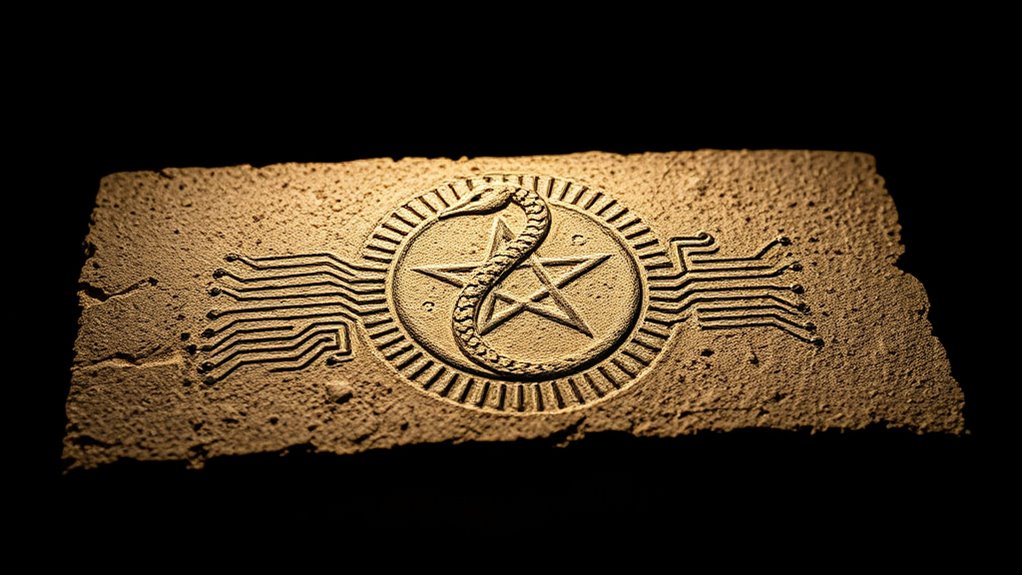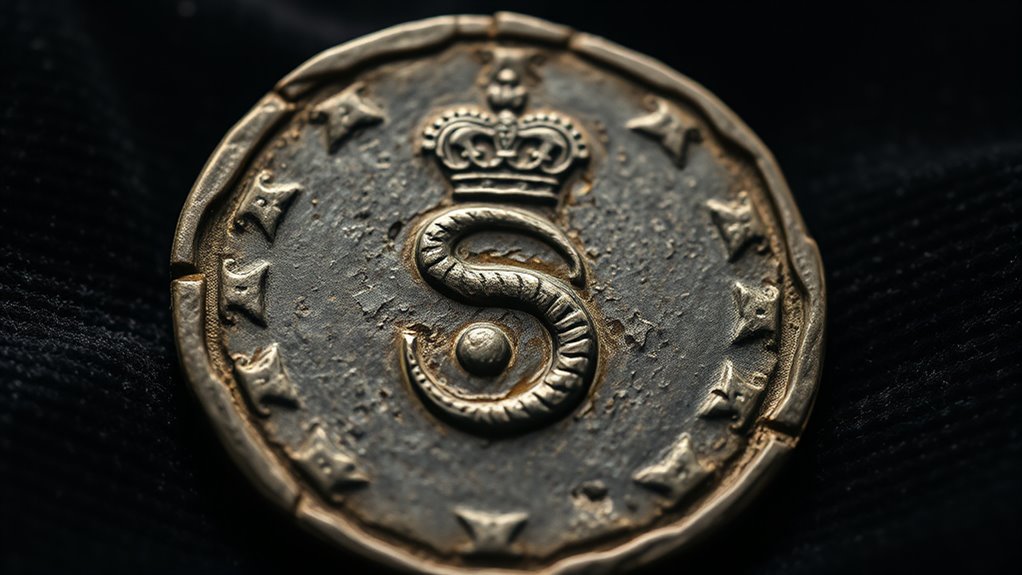The mark of the beast, based on biblical prophecy in Revelation, symbolizes allegiance to oppressive powers or spiritual deception. It’s often linked to imagery like a physical mark or a number, such as 666, representing evil or imperfection. While some see it as a literal symbol, others view it as a sign of spiritual loyalty. To understand its deeper meaning and modern relevance, keep exploring how it influences faith and end-times beliefs.
Key Takeaways
- The Mark of the Beast appears in Revelation 13:16-18 as a symbolic sign of allegiance to oppressive powers or spiritual loyalty.
- It is often associated with a physical mark on the hand or forehead, but also interpreted symbolically as loyalty to evil systems.
- The number 666 is linked to the mark, representing imperfection and evil, historically tied to specific figures or empires.
- Modern theories suggest the mark could involve biometric chips, digital IDs, or tracking technologies used for control and identification.
- Spiritually, the mark symbolizes allegiance to evil, prompting believers to remain faithful and discerning in end-times prophecy.
Biblical References to the Mark of the Beast

Biblical references to the Mark of the Beast primarily appear in the Book of Revelation, specifically Revelation 13:16-18. To understand these passages, you need to contemplate the historical context in which they were written, during early Christian persecution under Roman rule. The text has sparked numerous theological debates over its interpretation, especially regarding what the mark represents. Some scholars see it as a symbol of allegiance to oppressive political powers, while others view it as a spiritual or moral sign. The language used in Revelation is often symbolic and open to various interpretations, fueling ongoing discussions among theologians. Recognizing this background helps you grasp the significance and complexity of the biblical references to the Mark of the Beast.
The Origin and Meaning of the Mark in Revelation

The origin and meaning of the Mark of the Beast in Revelation are rooted in the symbolic language and historical context of the text. During the time Revelation was written, Roman imperial power and pagan worship held significant cultural symbolism, reinforcing authority and loyalty. This backdrop helps you see the mark as more than a literal symbol—it represents allegiance to oppressive systems. The imagery evokes ideas of ownership, control, and fidelity. Think of:
- A sealed mark pressed into the hand or forehead
- Roman coins bearing emperor’s image
- Symbols of loyalty stamped into flesh
- The cultural importance of branding in ancient societies
Understanding this context helps you grasp that the mark symbolizes a deeper spiritual allegiance, rooted in the societal and political realities of the early Christian era.
Symbolic vs. Literal Interpretations

Understanding the meaning of the Mark of the Beast involves exploring both symbolic and literal interpretations. Symbolic views often see the mark as representing cultural symbolism—ideas like allegiance to a system, authority, or spiritual loyalty. These interpretations draw on historical context, where symbols carried deep significance in different eras. On the other hand, literal interpretations suggest a tangible mark, such as a physical identifier or technology. You might think of it as a literal mark on the hand or forehead, as described in Revelation. Recognizing these perspectives helps you see how interpretations vary: some focus on spiritual or societal symbolism, while others consider concrete, physical meanings. Both approaches aim to clarify what the mark signifies and its potential implications.
The Number 666 and Its Significance

The number 666 appears in biblical references that many interpret as significant. You’ll want to explore how these scriptures are understood and what they symbolize. This leads to questions about whether the number has literal or symbolic meaning.
Biblical References Explored
Have you ever wondered why the number 666 is so closely linked to the concept of the Mark of the Beast? Biblical references reveal its significance through both historical context and cultural symbolism. In Revelation 13:18, the number is noted as a symbol of imperfection and evil. Historically, it’s believed to represent a specific figure or empire, rooted in numerology practices of the time. Culturally, 666 has become a powerful symbol of opposition to divine authority, evoking fear and caution. Visualize:
- Ancient scrolls with coded numbers
- Early Christian symbols intertwined with numerology
- Artistic depictions of apocalyptic scenes
- Modern interpretations linking the number to evil forces
These references deepen the mystery and symbolism surrounding 666 in biblical and cultural understanding.
Symbolic Interpretations Examined
Many interpret the number 666 as a powerful symbol representing imperfection, opposition to divine authority, and evil forces. Historically, this number has been linked to various cultural symbols, often seen as the “number of the beast.” Its origins stem from biblical texts, but over time, cultural symbolism has amplified its meaning, associating it with chaos and rebellion. During different eras, societies have used 666 to symbolize evil or opposition to God’s order, reflecting broader themes of moral struggle. The number’s significance isn’t limited to religious contexts; it’s also a symbol of fear and superstition rooted in historical interpretations. By understanding the historical context and cultural symbolism, you gain insight into why this number continues to evoke strong reactions and remains a powerful symbol of opposition to divine authority.
Modern Theories and Speculations

Many modern theories suggest that digital identification systems could be the mark of the beast, raising concerns about privacy and control. You might also encounter speculation about how future technologies could be used to track or influence people. Media often interprets these ideas through fictional stories, fueling fears and debates about the true meaning behind these developments.
Digital Identification Systems
Digital identification systems have become an integral part of modern life, with governments and corporations implementing biometric scans, RFID chips, and digital IDs to streamline access and security. These systems can identify you instantly, using biometric authentication like fingerprint or retina scans. They’re also linked to broader issues such as cryptocurrency regulation, ensuring secure transactions and preventing fraud. Imagine a future where your ID is embedded in a chip under your skin, controlling your movements or access to services. Visualize:
- Biometric scans at secure entry points
- RFID chips embedded in passports or cards
- Digital IDs stored on cloud platforms
- Facial recognition used in public spaces
You might wonder if these systems could be exploited or become the mark of control, raising questions about privacy and autonomy.
Future Technological Concerns
As technology advances rapidly, concerns about its potential misuse grow alongside innovations. Artificial intelligence develops at a swift pace, raising fears that it could be used to manipulate or control populations. Biometric tracking, already gaining traction, might become even more invasive, monitoring your movements, health data, and behaviors constantly. Some speculate that future systems could integrate AI with biometric data to create all-encompassing profiles, making it easier for authorities or corporations to influence or surveil individuals. These technologies could blur the line between security and loss of privacy, fueling fears that they might serve as tools for a modern “mark of the beast.” While these concerns are speculative, understanding their potential helps you recognize the importance of safeguarding personal freedoms in an increasingly connected world.
Interpretations in Media
Have modern media interpretations shaped how you comprehend the idea of the mark of the beast today? Absolutely. Pop culture often depicts it as a symbol of ultimate control or a dystopian future, fueling conspiracy theories about government surveillance or digital IDs. You might imagine:
- A glowing chip embedded under the skin during a high-tech medical procedure
- A QR code scanned at every transaction, linking you to an Orwellian system
- A sinister logo on your hand or forehead, visible to all
- Mass media warnings warning of a new world order
These vivid images are influenced by movies, TV shows, and online forums, blending fact and fiction. Media shapes your perception, making the mark of the beast a powerful symbol in modern conspiracy theories and pop culture narratives.
Implications for Faith and End-Times Beliefs

The mark of the beast holds profound implications for faith and end-times beliefs, shaping how many Christians interpret prophecy and spiritual preparedness. It often leads believers to examine Satanic symbols and other signs associated with end times prophecies, fueling fears of deception and spiritual compromise. For some, understanding the mark encourages vigilance against worldly influences that could symbolize allegiance to evil. It also prompts reflection on personal faithfulness and readiness for Christ’s return. Many see the mark as a warning to stay committed to biblical truth, resisting temptation and Satanic symbols prevalent in modern culture. Overall, these beliefs influence how you view current events and prepare spiritually for the possibility of end-times scenarios, reinforcing the importance of steadfast faith amid uncertainty.
Frequently Asked Questions
How Has the Concept of the Mark Influenced Popular Culture?
You see the concept of the mark shaping popular culture through apocalyptic symbolism and conspiracy theories. It’s often portrayed as a sign of the end times, fueling movies, books, and discussions about hidden agendas. You might notice how this idea sparks fears and intrigue, influencing everything from dystopian stories to online debates. The mark’s mysterious nature keeps it a powerful symbol, shaping perceptions of control, morality, and the future.
Are There Historical Examples Linked to the Mark of the Beast?
Imagine you’re exploring historical symbols linked to ancient prophecies, and you wonder if any tie to the mark of the beast. Historically, some interpret the Roman emperor’s seal or pagan symbols as possible precursors. These ancient signs, often misunderstood, reflect fears and beliefs of their time. While no direct connection exists, these examples show how societies used symbols to embody warnings or divine messages, echoing the idea of a prophetic mark.
What Are Common Misconceptions About the Mark of the Beast?
Many believe the mark of the beast is a literal symbol, but it’s often misunderstood. Common misconceptions include thinking it’s a specific chip or tattoo, while many see it as symbolic interpretations of loyalty or allegiance. Conspiracy theories also distort its meaning, suggesting it’s part of a hidden agenda. You should remember that most interpretations are speculative, and understanding its true meaning involves exploring biblical context rather than fear-driven myths.
How Do Different Religious Denominations Interpret the Mark?
You might think everyone agrees on the mark’s meaning, but religious denominations love to keep things interesting. Some favor symbolic interpretations, seeing it as a metaphor for loyalty or moral compromise, while others cling to literal understandings, believing it’s a physical mark or identifier. This variety fuels lively debates, ensuring that even in the face of unity, believers can find endless ways to interpret the mark—like a spiritual game of hide and seek.
Is There Scientific or Technological Evidence Related to the Mark?
You might wonder if scientific or technological evidence connects to the mark. Currently, biometric identification and microchip implants are real, used for security and convenience. Some speculate these could relate to the mark of the beast, but there’s no concrete proof. While technology advances, there’s no verified link between these innovations and any apocalyptic or biblical markings. Instead, they serve practical purposes in modern identification systems.
Conclusion
Understanding the mark of the beast isn’t just about ancient texts; it’s about safeguarding your soul from the ultimate deception. This symbol could threaten your faith, your salvation, even your very existence in ways you can’t imagine. Don’t ignore the warnings—stay vigilant, stay rooted in truth, and prepare yourself spiritually. Because if you’re not watchful, you might unknowingly walk straight into the trap that seals your eternity. Stay alert, and never take your faith lightly.










